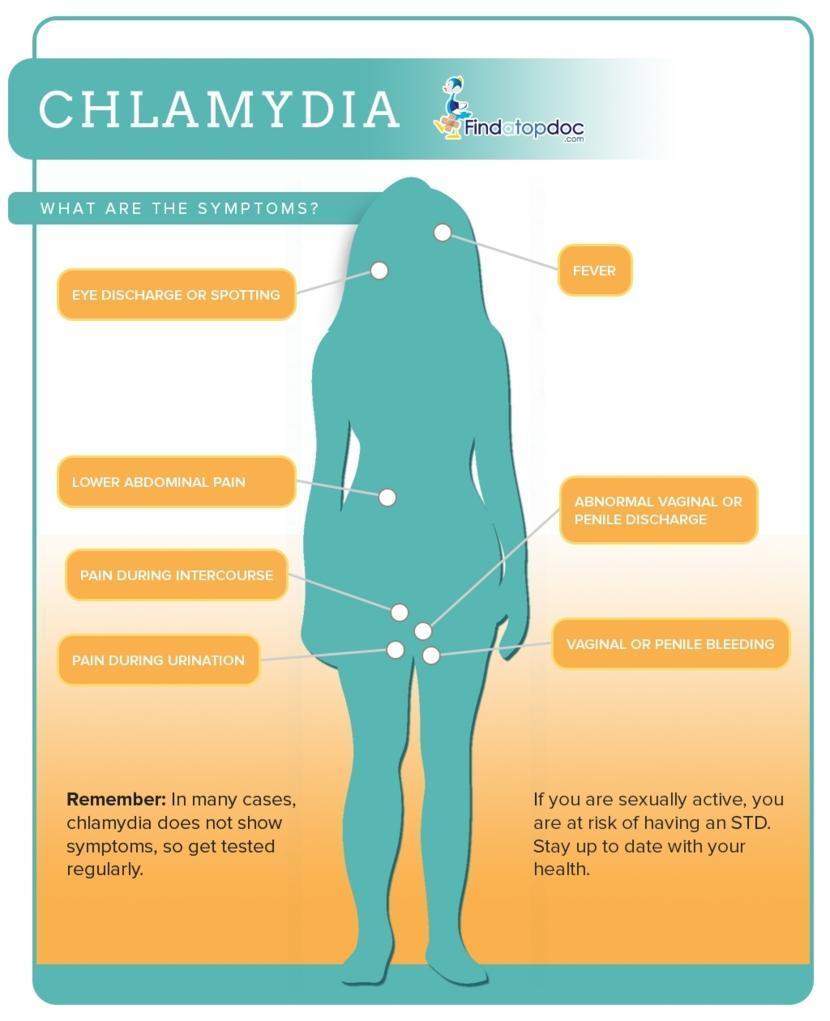Chlamydia in Men

What is chlamydia?
Chlamydia is one of the most widespread sexually transmitted diseases (STDs) in the United States. It is caused by the bacteria Chlamydia trachomatis. Chlamydia infection is more or less like gonorrhea in terms of its symptoms and format of spreading from one person to the other. There are around 2.8 million new cases of chlamydia every year in the Unites States that go undetected.
Chlamydia can be transferred through vaginal, anal, and at times even oral, sex. Chlamydia can be spread to the infected person's sexual partner even when the penis or tongue does not enter the vagina or anus completely. Sexual abstinence is the only way you can stay 100% safe from chlamydia and other sexually transmitted diseases. But if you are sexually active, limit your sexual partners and do not have unprotected sex.
Most people, be they men or women, who are suffering from chlamydia do not experience any symptoms, so they remain unaware that they are infected. This infection shows no symptoms in about 75% of women and 50% of men. Therefore, it can unknowingly be transferred from one partner to the other. Chlamydia can at times cause permanent damage to a woman's reproductive system and also increase the chances of ectopic pregnancy.
Chlamydia symptoms in women are pain while urinating, unusual vaginal discharge, bleeding between menstrual periods, and abdominal pain. Chlamydia symptoms in men are penile discharge, pain during urination, and burning and itching near the penis.
The most common test for detecting the presence of Chlamydia trachomatis is the urine test. This test is sensitive in nature and therefore gives out the right diagnosis and there is no chance of a false positive result. If a person tests positive, then he or she must consult a health care provider immediately for the right medication. Based on the condition of the patient, the health care provider will prescribe antibiotics to kill the bacteria present in the body.
Chlamydia can be easily treated and cured. But it is important that both sexual partners get themselves treated before again engaging in any sexual activity. Any such activity must be avoided until the infection is completely cured to prevent re-infection. The antibiotics course must be taken exactly as prescribed by the doctor and completed. Stopping before the completion of the course can lead to antibiotic resistance and reinfection.
What are the causes of chlamydia?
Chlamydia can be spread from one person to the other in the following cases:
- Unsafe vaginal sex with an infected person
- Unsafe anal sex with an infected person
- Unsafe oral sex with a person suffering from the infection
- Genital contact with a person suffering from the infection
Since chlamydia does not show any signs and symptoms in almost 70% of cases, there is the high probability of infected persons passing the disease on to their sexual partners without being aware of it.
A pregnant woman who has chlamydia can transfer the infection to her newborn baby during childbirth. The newborn baby may suffer from certain complications due to this infection, for instance, pneumonia.
Chlamydia cannot be spread through the following:
- Using a toilet used by a person who has this infection
- Sharing a sauna or swimming pool with a person suffering from this infection
- Physical contact with the surface an infected person has touched or coughed on earlier
- Sharing space (e.g. an office or apartment) with an infected person
What are the symptoms of chlamydia in men?
There are no signs and symptoms in at least 50% of the male population suffering from this infection.
When symptoms do appear, the more common ones are:
- Yellow to white penile discharge that may be thick, milky, or watery
- Pain during urination and ejaculation
- Rectal pain, discharge, or bleeding
- Red and inflamed eyes
- Red and inflamed joints
Some of the less common symptoms of chlamydia in men are:
- Burning and itchiness around the opening of the penis
- Testicular pain and inflammation, usually involving only one testicle
- Sore throat
How is chlamydia diagnosed?
There are different tests used for diagnosing chlamydia. The doctor may use a swab to collect a sample of the discharge from the urethra and send it for testing and analysis in the laboratory. The laboratory test will help identify the presence of the bacterium either through a bacteria culture or through the genetic material.
Conventional culture (swab) tests are the old, uncomfortable, less accurate, and slower method of detecting the bacteria and is no longer often used nowadays. Diagnosis is now usually through a nucleic acid amplification test (NAAT), a test that identifies the genetic material of the bacteria. Being a molecular test, it is more sensitive, specific, and accurate than conventional culture (swabs), and requires only a urine sample.
What else should one know with regard to chlamydia testing?
To get the most accurate results, one should not pass urine for at least two hours before collecting the urine sample.
If a person has had oral or anal sex and is experiencing symptoms of chlamydia, the doctor will do a swab of the throat or rectum. The sample will then be sent to the laboratory for testing.
What are the treatment options for men suffering from chlamydia?
If the test results are positive, consult the doctor for the right treatment without delay. The doctor will prescribe a single oral dose of antibiotics (for instance, azithromycin or doxycycline).
- Azithromycin: The doctor usually prescribes a single dose of this to the patient
- Doxycycline: The doctor usually prescribes pills for a one-week course. It is very important that the course be completed to avoid reoccurrence of the infection.
Some alternative antibiotics prescribed for chlamydia are erythromycin, levofloxacin, and ofloxacin. However, some patients may experience some side effects when they take these antibiotics. Among the side effects are diarrhea, abdominal pain, upset stomach, and nausea. But the side effects are usually mild. Some patients taking doxycycline may also have get rashes when exposed to the sun.
It is important for the patient to contact all his or her sexual partners and inform them that they too may have chlamydia, and to get themselves tested and treated right away. This is necessary to avoid reinfection and someone further passing on the disease unknowingly.
With the medication, the infection normally gets cured within one to two weeks. It is very essential to complete the entire course and not stop midway even if one starts to feel better and observes a reduction in the symptoms.
In women, severe chlamydia may require hospitalization, intravenous antibiotics, and pain relievers.
After the completion of the antibiotics course, a person should get tested again after three months to be completely sure that they have been cured. This is very important, more so if one is not sure whether his or her sexual partner has gotten treated. Sex should be out of the question until both the partners are very sure that they have been cured, to avoid reinfection.
Patients who are getting treatment for chlamydia are often simultaneously treated for gonorrhea, depending on the condition of the patient and if it is medically appropriate, i.e., when the patient has tested positive for both. This is because many people who have chlamydia actually usually also have gonorrhea. Therefore, doctors recommend treating both infections at the same time. The treatment for gonorrhea is another antibiotic, usually either cefixime (in pill or liquid form) or ceftriaxaone (given in a single shot).
Are there any alternatives to antibiotics?
Antibiotics are the only reliable treatment with a higher than 90% success rate of completely destroying the bacteria that cause a chlamydia infection.
If I get chlamydia once, can I get it again?
A chlamydia infection gets cured with treatment within a week or two. But yes, there is a possibility of getting the infection again. Getting cured from the disease does not mean one has gained immunity. Therefore, it is very important that sexual partners get themselves tested and treated immediately, and avoid sex until they are both cured, to reduce the possibility of reinfection.
What happens if one does not get his chlamydia treated?
Chlamydia should not be left untreated since it can lead to various health issues. If this infection is diagnosed in the early stages and treated in a timely manner, the risk of various complications is avoided. One can avoid complications with the help of regular screening and medical care as soon as symptoms manifest.
Untreated chlamydia in men is likely to harm their sperm and cause damage to their reproductive tracts, and thus cause permanent infertility.
Some of the complications of untreated chlamydia in men are as follows:
- Urethritis: This is the infection and inflammation of the urethra, which is the tube through which urine passes from the bladder right to the penis. A symptom of this condition is a discharge of mucus with yellow pus or clear mucus from the opening of the penis.
- Epididymitis: This is an infection of the epididymis, which is the structure within the scrotum, that is, the sac that holds the testicle gets inflamed. The symptoms of this condition are redness and inflammation of the scrotum (which feels warm to the touch), testicular pain, tenderness, and sweling (usually of only one), painful and frequent urination, painful intercourse and ejaculation, swollen lymph nodes in the groin, discharge from the penis, and blood in semen.
- Reiter syndrome: This is a chronic type of inflammatory arthritis that can affect both men and women. Some of the symptoms of this condition are arthritis, conjunctivitis, swelling of the genitals and urinary and gastrointestinal parts. It can also affect other organs and joints. A serious case of Reiter syndrome can harm the eyes, skin, kidneys, heart, lungs, and even mouth.
- HIV infection: Untreated chlamydia can increase the risk of getting infected with HIV.
- Affect sperm production: Men suffering from chlamydia produce sperm that are 80% more likely to have physical abnormalities and have 10% less mobility compared to those of men who do not have chlamydia.
How can a chlamydia infection be prevented?
Some of the preventive measures to reduce the risk of chlamydia are as follows:
- Use condoms properly every time you have sex.
- Abstain from sex or limit sexual activity to only one uninfected partner.
- If you suspect that you have chlamydia, avoid sex until you get tested and if infected, have completed treatment.
- Any symptoms related to the genitals like a discharge, burning sensation while urinating, or an unusual rash should be an indication to put a halt to being sexually active and visit a doctor for testing.
- If you have tested positive for chlamydia or any other sexually transmitted disease, start treatment immediately and inform all your sexual partners so they can get themselves tested, and treated if necessary.
- Since most people suffering from chlamydia do not show any signs and symptoms, it is best to get tested for chlamydia regularly if you have more than one sexual partner and have unprotected sex with any of them.














